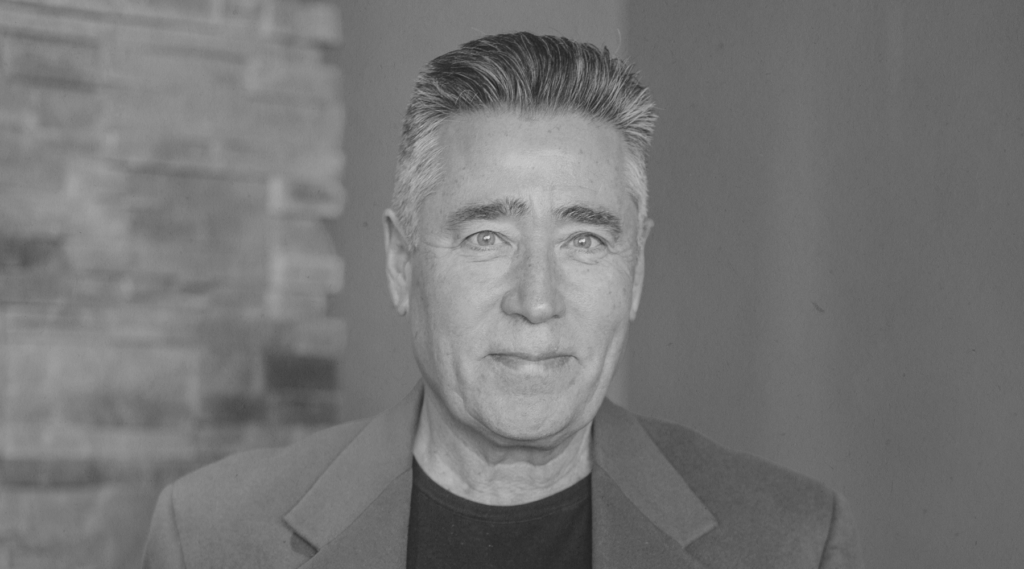Nick Schutt grew up in a town of 300 in rural Iowa. As a kid, he and his friends would ride bikes out to creeks or agricultural dredge ditches, catching tadpoles. They’d play in abandoned fields and water wells. They’d even drink from an old hand pump in one such field.
This may be a familiar story for folks in rural communities across Iowa, but it’s one that Nick now looks back on in horror. Alongside the minnows and tadpoles, he and his friends found empty, rusted-out chemical cans — including ones that held Monsanto’s Lasso, a toxic herbicide.
“We shouldn’t have been back there, catching tadpoles,” Nick says. “That should’ve been roped off. We didn’t know it would affect us back then. It’s affecting us now.”
Over the decades, Nick has seen Iowa transform. Once full of small farms and thriving agricultural communities, the state is now home to sprawling, industrial agricultural operations.
From warehouses stuffed with millions of animals to massive chemical-drenched cornfields, Big Ag has taken over the state. And it’s poisoning the water, too.
Iowa’s factory farm industry now raises 23.5 million factory-farmed hogs annually — one-third of all such hogs in the U.S. Yet since 1982, the number of Iowa hog farms plummeted by almost 90%. Many small family-owned operations are getting overtaken by a few massive factory farms.
Last year, Food & Water Watch spoke to Iowans who see, smell, and feel the disastrous impacts of Big Ag every day. What they told us aligns strikingly with what we see in the data.
The toll of Iowa’s polluted water is growing, and it will keep growing unless Iowa’s elected officials pass bold policies to hold the industry accountable and prevent more harm.
Factory Farms Flood Iowa’s Water With Dangerous Contamination
Corporate-run, industrial animal agriculture produces huge amounts of waste that directly impacts Iowans. Iowa factory farms produce 109 billion pounds of waste a year, 25 times that of the state’s human population.
With millions of animals in such a small space, all that waste has to go somewhere. The industry calls it “manure management,” but it’s more like mis-mananagement. Here’s how it works on Iowa’s factory farms:
First, manure collects in huge pits beneath barns. Then it’s applied, untreated, onto nearby fields, often at rates that far exceed the soil’s ability to absorb it; it then runs off and contaminates soil, rivers, streams, and even aquifers deep underground.
Over the past decade, Iowa’s Department of Natural Resources (DNR) issued enforcement notices for 179 manure discharge violations. That includes violations as massive as one million gallons of manure flooding into Iowa’s waterways.
Food & Water Watch mapped these violations and the waterways they impact across the state. Northwest Iowa is home to an extreme concentration of factory farms and has been hit especially hard. Six Northwest Iowa counties are among the top counties nationwide for factory farmed animal density.
In the map below, you can see when and where the DNR recorded manure violations over the past 10 years. Click on each red and yellow bullseye to see more information about each violation.
Moreover, the industrial production of corn and soy, which factory farms depend on for cheap feed, also contributes to the problem. The toxic fertilizers and pesticides used to grow these crops are leaching into waterways. Notably, 15% of Iowa’s corn goes to livestock feed, and over 60% feeds the ethanol industry (itself intertwined with factory farming).
The harm to Iowa’s water is widespread. In 2024, more than half of Iowa’s rivers and streams were designated “impaired.” (Another quarter of waterways didn’t have enough data to assess them.)
Factory Farm Waste Threatens Shared Natural Treasures
Leah Slick Driscoll was born and raised in Iowa. Her family takes every opportunity to hike, swim, and visit the state’s public beaches. After a long hike, her kids love cooling off by jumping into lakes and streams.
But these joys have been curtailed in recent years. Since 2019, E. coli advisories have risen across Iowa’s beaches. E. coli can cause gastrointestinal illnesses, meningitis, and even death in vulnerable populations. And manure pollution is a major source of E. coli contamination.
One of the most affected beaches is Backbone State Park Beach, one of the Driscolls’ favorites. According to one park ranger, 86,000 acres of farmland drain into the small 50-acre lake. This past summer, Backbone State Park saw an E. coli reading 85 times higher than Iowa’s safety standard.
The possibility of contamination is now a specter looming over every trip the Driscolls take. “It kind of dictates where you even feel comfortable going as a family,” Leah said. “And maybe you then just do it less than you would’ve.”
This past summer, Leah said her family had to reroute their beach plans at least ten times because of these advisories. It was one of the state’s worst years for beach closures in recent memory — the DNR issued 134 E. coli warnings across 39 public beaches.

Iowa’s Polluted Water Flows Beyond State Borders
As a member of the Meskwaki Nation, Leah sees Iowa’s water pollution not only as a threat to her family’s health, but also to her people’s way of life.
For the Meskwaki people, caring for the land is essential, and water is “the center of who we are,” Leah said. “The Earth and water and nature is an animate being, and it has its own right and its own spirit.”
The Meskwaki Nation embodies these values by running an organic food sovereignty farm; the Meskwaki high school where Leah teaches has a garden and greenhouse, which provide food for school meals.
But bad neighbors threaten these values and practices. Upstream, industrial agriculture is polluting the Tribe’s waterways.
“We don’t have the power to make Iowa laws, but we’re affected by Iowa laws, or lack thereof,” Leah explained.
Iowa’s factory farm pollution also flows far, far downstream. It contaminates water and land all throughout the Mississippi River Basin. Then, it flows down into the Gulf of Mexico. From more than a thousand miles away, Big Ag pollution is putting whole marine ecosystems at risk.
Iowans Pay the High Costs of Treating Factory Farm-Polluted Water
Iowa factory farms paid less than $730,000 in punitive penalties for 179 illegal manure spills in the past decade. Yet, Iowans may pay up to $66 million a year to clean up Big Ag’s nitrate pollution. Notably, these costs are showing up in people’s water bills.
Joe Henry has seen this first-hand. He’s lived in Iowa since he was three and is a dedicated activist with Iowa’s labor and Latino communities.
His water provider is Des Moines Water Works (DMWW), which serves over 600,000 Iowans. Over the past decade, Joe’s average monthly water bill has doubled from $50 a month to over $100, in part due to agricultural pollution, he said.
With more pollution, public water utilities face more expensive and dangerous nitrate contamination.
Nitrates are linked to health problems like thyroid disease and fatal “blue baby syndrome.” Research has also linked ingesting nitrates to cancers, even at levels under federal limits. And the threat of nitrates especially impacts low-income communities and communities of color in Iowa, which see higher exposure rates than the state average.
Though it’s hard to trace nitrates to single sources, areas with more industrial agriculture have higher concentrations of nitrates in their water. DMWW is a textbook example of this: it primarily sources its water from the Des Moines and Racoon Rivers. Both watersheds are dominated by row crops and factory farms. Fertilizers contribute over half of the nitrate in the two rivers, and manure from factory farms contributes another 15%.
Joe tied water quality issues directly to the state’s permissive laws for factory farming. A 1995 law made it easier for factory farms to get bigger than ever — and get bigger they did. That period of time, Joe says, “really led to the poisons in our water.”

Without Action, More Families Will Lose Clean Water
To meet federal standards, DMWW operates one of the largest nitrate removal systems in the world. Attempts to hold the industry accountable for this pollution were unsuccessful, so now ratepayers are responsible for the high cost of treatment. Constructing the system cost over $4 million, and operating costs can run as high as $16,000 a day.
As climate change worsens, these costs will only rise. More drought followed by heavy rains (a pattern that climate change makes increasingly common) leads to higher concentrations of nitrates in water. As DMWW works to adapt its infrastructure, users will likely see rate hikes of up to 10% each year.
Rising water bills particularly burden low-income families, who pay a higher percentage of their income on essentials like water. When families miss water bills, they can see their taps shut off completely. In fact, in 2018, Food & Water Watch found DMWW to have the seventh-highest shut-off rates in the nation.
After a shutoff, families must pay a steep fee to have their water turned back on — one that may be unaffordable for many.
Nitrate pollution doesn’t just affect those who pay for public water. It also affects the 260,000 Iowans who rely on private wells. The DNR found that about 1 in 10 wells have nitrate concentrations above the EPA’s action level (the level at which public systems must treat the water to prevent health harms).
But unlike water utility customers, private well owners bear the cost of treating nitrates entirely on their own. That requires buying and installing home filters themselves, which can cost hundreds of dollars or more.
For many Iowans, the high costs of addressing Big Ag’s nitrate pollution make clean water inaccessible.
Read more about Big Ag’s impact on Iowans like Leah, Joe, and Nick in our new report, Drinking Dirty Water: Living With Big Ag’s Pollution in Iowa.
Factory Farm Pollution Leads to Unimaginable Loss
This pollution is not only raising costs — it’s endangering lives.
This is something Joe knows well: his wife passed away two years ago from cancer. “I’ve always felt that our water quality, of lack of it here in the state, led to the breast cancer that she had,” he told us.
Joe is far from the only one. Nick Schutt, who once played amongst tadpoles and herbicide cans, has 17 parents, siblings, cousins, aunts, and uncles who have suffered from cancer over the past few decades.
Three of his four siblings have been diagnosed with cancer, and he told us he has found benign cysts all over his body.
It’s no surprise to Nick that Iowa has the fastest-growing rate of new cancers and is second in cancer incidence overall. “I can’t believe Iowa’s not number one,” he said, “with the gallons and gallons of chemicals and herbicides that I see going up and down the road every day.”

There are clear links between agricultural pollution and cancer. For instance, nitrates convert to cancer-causing compounds in the body. Many pesticides may disrupt thyroid function, contributing to the risk of thyroid cancer.
One report projects that in 2024, 21,000 new cancers will have been diagnosed in Iowa and 6,100 Iowans will have died. Nick sees this happening more and more. “It seems like people around here are dying younger and younger all the time,” he said. “You go to their service, and everyone gets the general consensus: it was too early for them.”
Cancer mortality is not distributed evenly, either. Iowa has the third highest cancer mortality rate for Black residents, and death rates for breast and prostate cancers are higher among the Black population compared to the state as a whole.
Big Ag Harms in Pursuit of Profit — And Iowa Leaders Allow it
Iowa has become a sacrifice zone for Big Ag; a place where health and quality of life are sacrificed for profit.
Raising animals at such a destructive scale is a want, not a need, said Leah: “It’s a for-profit business, and everyone is being asked to pay the price for it.”
Leah, Joe, and Nick all expressed distrust toward officials for their handling of this crisis and treatment of factory farms. Notably, Iowa depends on a permit system to monitor and limit pollution — yet, over 4,000 factory farms in the state operate without a permit, with massive amounts of manure pollution going unreported.
This directly benefits factory farms, allowing them to offload the costs of their waste onto everyone else. This system “makes me feel as if whoever is making that policy is bought and paid for,” Leah said, “and they don’t care about the people of Iowa.”
Moreover, the DNR depends on self-reporting to identify manure spills. This will never be effective, as factory farms have an incentive to hide illegal spills. In recent years, lawmakers have also cut budgets for the DNR and water quality monitoring. Without these resources, it will be increasingly hard to understand and solve the crisis.
Then, in April 2024, the Iowa State Senate voted to shield Bayer from lawsuits over harms caused by Roundup, the corporation’s toxic weedkiller. While the bill didn’t make it through the State House in 2024, lawmakers reintroduced it in late January this year.
“Right there is showing a cover-up,” Nick said. “People should have the right to be reimbursed or redeemed for the damages done.”
All this points to leaders protecting Big Ag’s business model — and its profits — over the health and well-being of their constituents.
Iowans: Join our fight against Big Ag! Tell your representative to reject the Cancer Gag Act!
To Save Iowa’s Water, Rein in Big Ag
Iowa’s factory farm pollution crisis is growing to new heights. Right now, Big Ag has no incentive to change. Corporate agriculture, from fertilizers to factory farms, is making massive profits by ruining Iowans’ health and environment.
To address the crisis, all three interviewees agreed, the state urgently needs policy action that finally reins in Big Ag.
When Nick asked his family if he could share their stories, they responded, “Share the story, please, share the story.” “My family’s scared,” he told us. “My neighbors are scared. We gotta get something going.”
Without action, Iowa will see more lost green spaces, more expensive drinking water, and more lost loved ones for generations to come.
“What does it look like when my grandchildren have children?” Leah wondered. “Will they even be able to swim at any beach in Iowa? Or use the water in any way? Will they even be alive if we don’t have fresh, drinkable water?”
Joe emphasized that to ensure clean water for all, Iowa can’t rely on individual changes and big, expensive treatment systems. It needs strong legal and legislative action on factory farms.
“It would definitely change the way in which food production is done, the way in which farming is done,” he said. “Clearly more needs to be done, because no river is safe now, no beach is safe.”
Reversing course is possible. Iowans across the state are coming together to fight Big Ag; to grow food sustainably and steward the land. But we also need elected officials who have the courage to stand up to corporate giants and pass bold policies that finally put people before profit.
Iowa leaders must:
- Pass the Clean Water for Iowa Act. We’ve seen that Iowa’s corporate agriculture industry will not regulate itself. Lawmakers must pass the Clean Water for Iowa Act, a mandatory approach to keeping waste out of our water.
- Pass a factory farm moratorium. The legislature must also stop the expansion and building of factory farms to prevent this crisis from worsening.
- Stop Big Ag power grabs. Iowa’s elected officials must reject any efforts, including the Cancer Gag Act, to protect the manufacturers of dangerous pesticides and chemicals used throughout the state for industrial agriculture.


